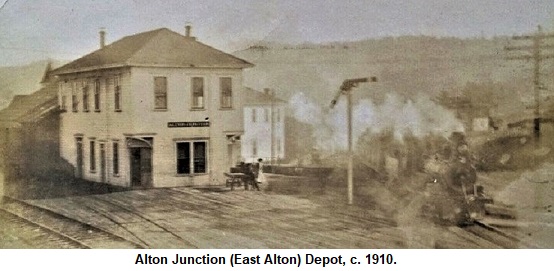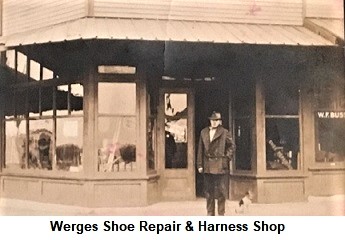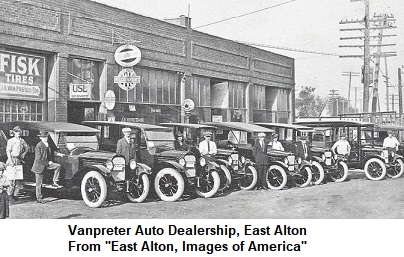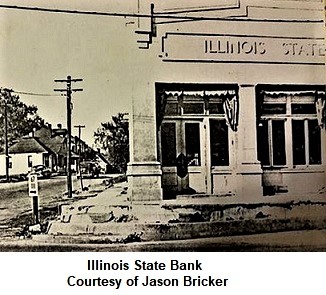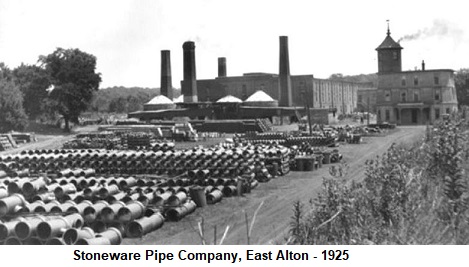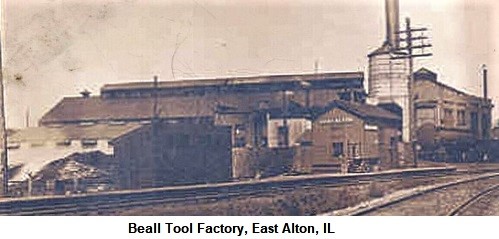Early East Alton History
(Also called Alton Junction, Wann Junction, and Emerald)
East Alton Newspaper Articles | Wann Disaster
A small Indian village once stood near the future East Alton.
This land later became the Reuter farm, when William and Annie
Reuter, natives of Germany, settled there sometime before 1862. This
large tract of the land became the site of the East Gate Shopping
Center.
Settlers from the town of Milton, located on the west side of the
Wood River Creek, fled their town in 1806 when an epidemic of
malaria occurred, believed to be caused by the damming of the waters
of the Wood River Creek for mill purposes. Some of those who
survived moved only as far as the east side of the Wood River Creek
in what would become East Alton to establish new homes for
themselves.
A small fort was constructed in 1811 by James Beeman on Section 21
of Wood River Township, about one mile south of the old town of
Milton, across the Wood River. His wife was Nancy Moore Beeman,
sister of Abel Moore of the
Wood River
Massacre. During the War of 1812, the fort provided protection
from hostile Native Americans.

In 1821, a large area of land which later became East Alton was
deeded by U. S. President James Madison to Solomon Preuitt, son of
Martin Preuitt, one of the earlier settlers in Milton. Land east of
the Big Four Railroad tracks was deeded by the government to
Zephaniah B. Job in 1856, and for a time, a small community was
known as “Job.”
East Alton was an important railroad junction. From 1837 to 1854,
the Chicago & Alton, the Indianapolis & St. Lous, and the Terre
Haute & St. Louis Railroad combined and were operated the “Bee
Line.” In 1868, the Cincinnati, Cleveland, Chicago & St. Louis
Railroad (also called the Big Four) became known with through trains
from St. Louis to New York. More familiar to locals was a train
between Alton and East Alton that the locals called the “Plug.” It
provided service until March 3, 1939. In November 1881, the
Indianapolis & St. Louis Railroad changed the name of the depot from
Alton Junction to Wann Station.
In 1853, George and Sally Smith, George A. Smith, and George W. Carr
purchased 180 acres in what would be the future East Alton. On
October 26, 1854, George and Sally Smith sold their interest to
George A. Smith and George W. Carr, who in 1858, platted a town just
south of the Alton Junction Station. The plat was recorded July 14,
1858, and the town was named Emerald, with the main street named
Shamrock, due to the large influence of the Irish who came during
the railroad boom. Many people, however, including the railroad,
continued to refer to the area as Alton Junction. Lots in Emerald
were sold to John Delno on June 27, 1859, and on March 23, 1860,
Jeremiah Danaan purchased lots. These two men were the first
permanent settlers of the village of Emerald.
A school was opened in 1867 in a one-room building at the corner of
Shamrock and Main Streets. It was heated by an open fireplace. Not
only children, but adults enrolled to learn to read and write. The
floor, benches, and furniture were made of split logs. This school
was abandoned in 1870, when it was replaced by the Blackjack School
(also known as Emerald School), built on the site of the future
Washington School. The land for Blackjack School was donated by
Zephaniah Silver.
A “Driving Park,” or horse-racing park, was located in future East
Alton near the Wood River. It was owned by Zephaniah B. Job. The
track was a mile long, and included a hotel and grandstand. It was
in operation in the 1870s. The hotel was burned down on May 4, 1874,
by James Smith and William Clayton.
On January 21, 1893, the worst railroad disaster in Illinois
occurred at Wann. The Southwestern Limited 109 was running late
going into Wann and came upon an open switch. The train crashed into
a freight train, whose cars were loaded with oil, causing a huge
explosion and fire. Residents rushed to give aide to the injured,
but when the oil cars exploded, burning oil rained down upon them,
causing 41 to lose their lives, and at least 75 were injured. A new
church was in the process of construction when the disaster struck,
and a temporary floor was quickly laid so that funeral services
might be conducted in an official house of worship. As a result of
the tragedy, each member of the church contributed one dollar for a
memorial bell to be made and hung in the church, in memory of those
who perished. Among them was Harry Wiegand, a church deacon, in
whose memory the bell was dedicated.
CLICK HERE TO READ THE STORY
OF THE
WANN DISASTER.
East Alton was incorporated as a village on September 4, 1893. D. G.
Tomlinson was the first president of the board of trustees, with
James Luddike as clerk. The first postmaster was William Evergum,
who was also station agent. In March 1895, the names of Alton
Junction, Wann Station, and East Alton were all combined to simplify
things and to end confusion. The village hall was completed and
dedicated in May 1898, with Dr. C. M. Pence as Mayor, and Zephaniah
B. Job delivering the dedicatory address.
EARLY BUSINESSES IN EAST ALTON
Four Mile House
Four Mile House – so named because it was four miles from the Alton
City Hall - was a tavern located on West St. Louis Avenue (where the
Ritz Theater would later be constructed). This tavern served as a
post office and stage coach stop.
Hotel Wann
The Hotel Wann was owned by George Y. Smith. In January 1886, the
hotel caught fire and was totally destroyed. The flames originated
from the flue. The hotel was a two-story, brick and frame building.
Otis Cruse Blacksmith Shop
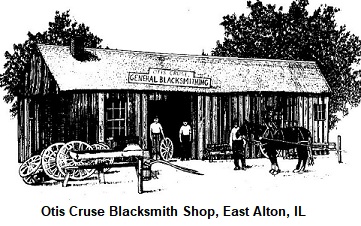 Otis Cruse established a blacksmith shop in 1882 on the corner of
St. Louis Street and Goulding Avenue. Cruse’s business flourished in
the 1890s, but was a victim of progress, when autos became the norm.
Later, the Ritz Theater was built on the site.
Otis Cruse established a blacksmith shop in 1882 on the corner of
St. Louis Street and Goulding Avenue. Cruse’s business flourished in
the 1890s, but was a victim of progress, when autos became the norm.
Later, the Ritz Theater was built on the site.
John Jones Grocery
The John Jones Grocery was located at the corner of West Main Street
and West St. Louis Avenue. It was operated by John Jones and his
nephew, Earl Jones.
Hale Barber Shop and Hardware and Lumber Store
Prominent business men in the early days of East Alton included
Lawrence and Clarence Hale, twin brothers who first operated a
barber shop, and in 1915 joined their brother, Walter, in a hardware
store and lumber business, buying out Fred Crandall.
Silver Ridge Market
The Silver Ridge Market was established in 1899, and was ran by H.
Frank Yoder Sr. The business was later moved to 636 Broadway, where
Silver Ridge was located. In 1949, Robert Dunn purchased the
business.
Vanpreter Drygoods
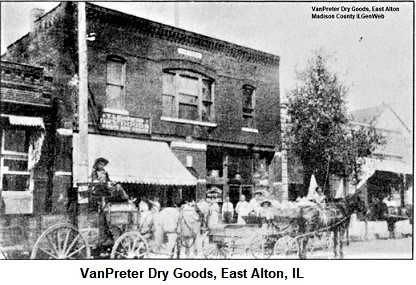
Charles Vanpreter followed in his father’s footsteps, both as a
leading merchant and as mayor, where he served 18 consecutive years
until 1949, and after an absence of one term, was returned to office
in 1953.
Ringering Grocery Store
The Ringering Grocery Store was established in 1920 by George H.
Ringering at 628 West St. Louis Avenue.
Werges Harness Shop
The Werges Harness Shop was established by Herman W. Werges at the
corner of West St. Louis Avenue and Smith Street.
Community Coal and Ice
The Community Coal and Ice was established in the early 1920s. It
was located at North Shamrock and Main Streets.
The Big Five Saloon and Hotel
The Big Five Saloon and Hotel was established by Joe Heiens at
Shamrock and East Main. The business included a lunch room.
Prohibition put the Big Five out of business in the 1920s.
J. B. Vanpreter & Son Auto Dealership
The J. B. Vanpreter & Son Auto Dealership was established in 1917.
They sold Willys-Knight and Overland cars. The business was located
on West St. Louis Avenue.
Illinois State Bank
The Illinois State Bank was established in 1904, and was located on
West St. Louis Avenue. In the 1920s, the bank was moved to the
corner of West St. Louis Avenue and West Main Street, replacing the
John Jones Grocery.
The Stoneware Pipe Company
The Stoneware Pipe Company was founded in East Alton in 1870 by
Alfred F. Foster. This company, located on what would become Powder
Mill Road, produced clay products made from minerals found in the
local clay mine, which ran eastward from East Alton. The clay in the
ground was 8 to 9 feet thick. Alfred Foster was the first man in the
west to produce 32-inch tile, and was the second man in the United
States. He died in 1902 at the age of 65 and is buried in the Alton
City Cemetery. The company remained in business until the late
1930s, when the property was purchased by the Olin Corporation.
Equitable Powder Company, Western Cartridge Company, and Union
Cap and Chemical
In May 1892, the Equitable Powder Company was organized by Franklin
W. Olin and business associates from the east, Clarence F. and A. W.
McMurray and John J. Nef. These friends became officers and board
members of the new company. On July 9, 1892, Olin took possession of
the land bordering the Wood River Creek at East Alton. Olin and Ed
James and
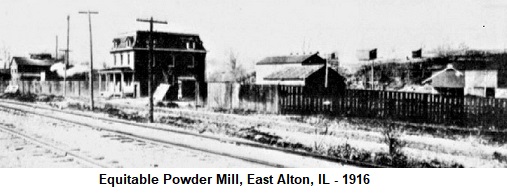
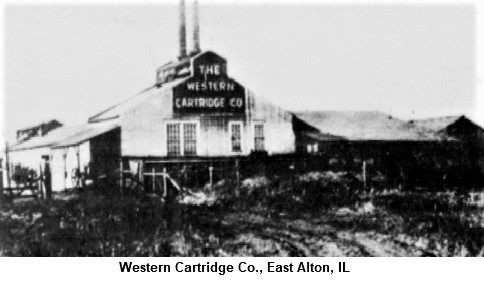
Business competition was intense and unregulated, and both Equitable
Powder and Western Cartridge were in business battles from the
beginning. A powder mill (Phoenix) was constructed in Belleville
shortly after Olin founded Equitable Powder Mill in East Alton. A
bitter price war resulted, eventually won by the Equitable Mill.
Eventually Olin was persuaded to take over the Phoenix Company. He
closed the Phoenix office and moved it to St. Louis, where he
successfully managed it and his own companies for six years.
DuPont was a formidable rival in the industry, and it had been
buying up shares of Equitable Powder stock almost from the time
Franklin Olin founded the company. In 1896, Eugene DuPont was seated
on the board of directors of Equitable Powder. In 1902 Eugene was
succeeded by T. C. Coleman DuPont, who in 1903 became a
Vice-President of Equitable.
Competition was equally intense in the ammunition business. When
Western Cartridge went into the ammunition production business, it
was classified as a loading operation by the trade. The company
bought all its components except gun powder in the open market –
most of them from Winchester and Union Metallic Cartridge Company.
At the turn of the century, both Winchester and Union Metallic
discontinued the sale of components. Therefore, Western had to
obtain components from small jobbers, resulting in lack of
uniformity and quality. Consequently, Western Cartridge Company was
forced into growth. Franklin Olin resigned from the presidency of
Phoenix in 1903 to devote greater efforts to his own ammunition and
other businesses. Eventually, he withdrew his companies from the
Gunpowder Trade Association, thus escaping antitrust litigation.
In 1903, Olin and Almon Lent, president of the Austin Cartridge
Company of Cleveland, established the Union Cap and Chemical Company
to manufacture primers and .22-caliber ammunition in East Alton, for
Western and the Austin company. Production began in a new building
in a cornfield, across Wood River Creek from the Equitable Powder
mill. In 1907, Western Cartridge bought Austin Cartridge and the
Austin company’s interest in Union Cap and Chemical. A Western
Cartridge sign went up on the side of the building in the East Alton
cornfield. It was the first building the young ammunition company
could call its own. Previously, it had shared quarters on the other
side of the creek with Equitable Powder. In 1908, Lent became a
member of the Western Cartridge board of directors, a member of the
executive committee, and a vice-president of the company.
Franklin Olin had been able to overcome ammunition component
problems faced by his company. He invented his own equipment for
manufacturing paper shot shell tubes. Lead shot was bought at first
from a shot tower in nearby Granite City. When that facility was
sold, the cost of lead shot was hiked. But Olin was prepared for the
increase. What had appeared to be a grain elevator built just months
earlier on the property of Western Cartridge, actually was a shot
tower he had built in anticipation of such a need. The Western
Cartridge Company showed a profit for the first time in 1906.
Equitable Powder was profitable from its beginning.
Beall Shovel Company and Beall Tool Company
The Beall family of Alton originally operated three factories –
Beall Brothers, Beall Shovel, and Charles W. Beall Manufacturing.
The three were united in 1905. Beall Tool Company was founded in
1905 by Charles W. Beall. This company was sold to Hubbard & Co.,
and later sold to Mark D. Speciale in 1984. It was then called Beall
Manufacturing Inc. The East Alton plant was damaged by fire in 1910,
but was repaired. A new steel rolling mill furnace was installed
there in 1917. The Beall Shovel Company was erected in East Alton in
1904. In 1907, some of these shovels were used in digging the Panama
Canal.
The Bowman Stockyards
During WWI, H. J. Bowman was a buyer of horses for the French and
Belgian governments and the U. S. Army. He fenced in part of his
property, which was along the Big Four railroad, not too far from
Wann Station, and cared for the horses there until they were shipped
out. More than 250,000 horses were brought in to the stockyards. In
June 1915, a large storm caused the 7,200 horses to stampede and
escape from the stockyards. The horses caused quite a disturbance.
Herman Wuestenfeldt, who was returning from Alton, sustained
fractures of three ribs when the horses coming down the road
encountered the auto in which Wuestenfeldt was driving. Inside the
auto also were Nola, William, Gussie and Loretto Carstens. Trains
were delayed because of the horses, and eight of them were killed by
a fast freight train on the Chicago & Alton Railroad. Two were shot
to permit the Midnight Special to pass on. Hundreds of horses were
penned up by nearby property owners, who filed damage claims against
the stockyards. The village of Wood River suffered heavily from
damaged done to young trees which had been set out the previous year
along the streets. Finally, the horses were rounded up and returned
to the stockyards. A gang of one hundred men were put to work
building more fences and barns.
THE COMMUNITIES OF NIAGARA, SILVER RIDGE, AND BLINN
Niagara was a community founded by Zephaniah B. Job in 1904, and
was located on the east side of the Wood River Creek, directly
across from the old town of Milton. Job named the area Niagara, in
honor of the falls in the Wood River over the Powder Mill dam. There
were 35 lots in the tract, which were surveyed by Messrs. Long and
Swift.
Silver Ridge was founded in 1909 by Zephaniah Silver. It was annexed to East Alton in 1910. Among those who built homes there, were Charles Chessen, Ed Doerr, Ed Walls, Frank Eudy, Lee Bracken, and Jesse Jones.
Blinn was also founded by Horatio J. Bowman in 1910. It was
located east of the Silver Ridge addition, and was part of the Job
estate. Joseph Heins acted as realtor to sell the lots. Charles
Glass was one of the first to buy property in Blinn and build a
house.
